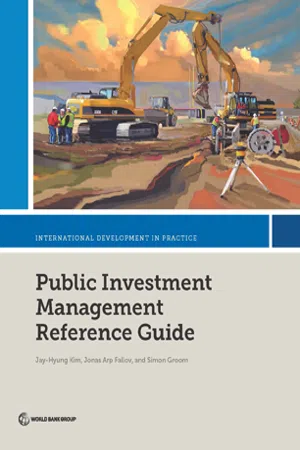
- English
- PDF
- Available on iOS & Android
Public Investment Management Reference Guide
About This Book
The Public Investment Management (PIM) Reference Guide aims to convey country experiences and good international practices as a basis for decisions on how to address country-specific PIM reform agendas. The country references are drawn largely from previous diagnostics and technical assistance reports of the World Bank. The application of country diagnostics and assessments has revealed a need to address the following issues when undertaking a country reform in PIM: • Clarification of the definition and scope of public investment and public investment management • Establishment of a sound legal, regulatory and institutional setting for PIM, making sure it is linked to the budget process • Allocation of roles and responsibilities for key players in PIM across government • Strengthening project pre-appraisal, appraisal, and selection/prioritization procedural guidance, and deepening project appraisal methodologies • Integration of strategic planning, project appraisal/selection, and capital budgeting • Management of multiyear capital budget allocations and commitments • Ensuring effective implementation, procurement, and monitoring of projects • Strengthening of asset management and ex post evaluation • Integration of PIM and public-private partnership (PPP) in a unified framework • Rationalization and prioritization of the existing PIM project portfolio • Development of a PIM database and IT in the form of a PIMIS (PIM Information System). The PIM Reference Guide does not seek to provide definitive answers or standard guidance for the common PIM issues facing countries. Nor does it seek to provide a detailed template for replication across countries: this would be impossible given the diversity of country situations. Instead, each chapter of the guide begins with an overview of a specific reform issue, lists approaches and experiences from various countries, and summarizes the references and good practices to be considered in designing country-specific reform actions.
Frequently asked questions
Information
Table of contents
- Front Cover
- Contents
- Foreword
- Acknowledgments
- About the Authors
- Abbreviations
- Chapter 1: Introduction
- Chapter 2: Establishing the Concept and Scope of Public Investment Management
- Chapter 3: The Legal and Regulatory Framework for PIM
- Chapter 4: Allocation of Roles and Responsibilities among Key Players
- Chapter 5: Designing the Project Appraisal and Selection System: Quality-at-Entry Processes
- Chapter 6: Integrating the Strategic Planning, Project, and Budgeting Cycles
- Chapter 7: Upgrading Capital Budgeting Practices
- Chapter 8: Project Implementation, Monitoring, and Adjustment
- Chapter 9: Ex Post Review and Asset Management
- Chapter 10: Integrating PIM and PPP in a Unified Framework
- Chapter 11: Rationalizing a Nonperforming PIM Portfolio
- Chapter 12: PIM Information Systems: Requirements, Options, and issues
- Appendix A References for International Guidance on Designing Appraisal Methodologies
- Appendix B Further Issues in Developing an Economic Appraisal Methodology
- Appendix C Examples of Project- and Portfolio-Level Management Support Capabilities Provided by a PIM Information System
- Appendix D Types of Content for a PIM Information System Database
- Boxes
- Figures
- Tables